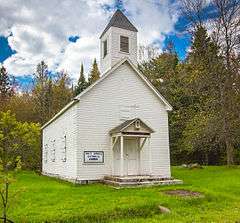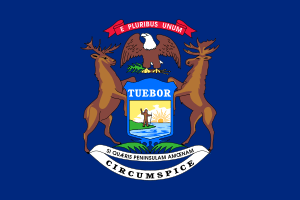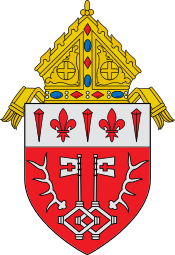Church of Our Saviour, Friend of Children
|
Church of Our Saviour, Friend of Children | |
 | |
 | |
| Location | North Shore Rd., Payment Settlement on Sugar Island, near Sault Ste. Marie, Michigan |
|---|---|
| Coordinates | 46°31′45″N 84°9′4″W / 46.52917°N 84.15111°WCoordinates: 46°31′45″N 84°9′4″W / 46.52917°N 84.15111°W |
| Built | 1856-57 |
| Built by | Michael G. Payment |
| NRHP Reference # | 82002831[1] |
| Significant dates | |
| Added to NRHP | July 08, 1982 |
| Designated MSHS | January 19, 1978[2] |
Church of Our Saviour, Friend of Children, also known as Holy Angels Roman Catholic Church, is a church located on North Shore Road on Sugar Island, near Sault Ste. Marie, Michigan. It was designated a Michigan State Historic Site in 1978[2] and listed on the National Register of Historic Places in 1982.[1]
History
Michael G. Payment was born in Montreal in 1814.[3] In 1827 he moved to Detroit and became involved in business.[3] He soon was put in charge of cargo shipments, in which capacity he traded goods with Indians.[3] In 1845, Payment moved to Sugar Island and established a small settlement, known at the time as "Payment's Landing" or "Payment Settlement."[2] Payment undertook trade with the local Ojibwe people, establishing a successful trading post. Beginning in 1853, Bishop Frederic Baraga was a frequent visitor to the settlement, and in 1856 Baraga purchased lumber and requested that Michael Payment construct a church at the site. Payment complied, and the building was completed in 1857.[2]
Michael Payment returned to Detroit in 1874,[3] but regular services were held at the church[4] until it closed in 1953.[2] The church reopened in 1982 for services in the summer.[2] It is the last remaining structure from Payment's Landing.[2]
Description
Church of Our Saviour, Friend of Children is a single story frame structure sitting on a fieldstone foundation. The exterior was originally clad in clapboard, but at some time weatherboarding was installed over the original siding.[2] The church has a gable roof with a square, pyrimidal-roofed belfry at the top. Each side has three windows, and one end has an entry portico below a plain wooden cross.[2]
See also
 Catholicism portal
Catholicism portal Michigan portal
Michigan portalNational Register of Historic Places portal
References
- 1 2 National Park Service (March 13, 2009). "National Register Information System". National Register of Historic Places. National Park Service.
- 1 2 3 4 5 6 7 8 9 State of Michigan (2009). "Church of Our Saviour, Friend of Children". Historic Sites Online. Michigan State Housing Development Authority. Retrieved June 26, 2010.
- 1 2 3 4 Barnard, F. A. (1878). American Biographical History of Eminent and Self-Made Men: Michigan Volume, Part 1. Western Biographical Publishing. p. 112.
- ↑ "Sacred Heart, Sugar Island". Diocese of Marquette. Retrieved April 22, 2012.
